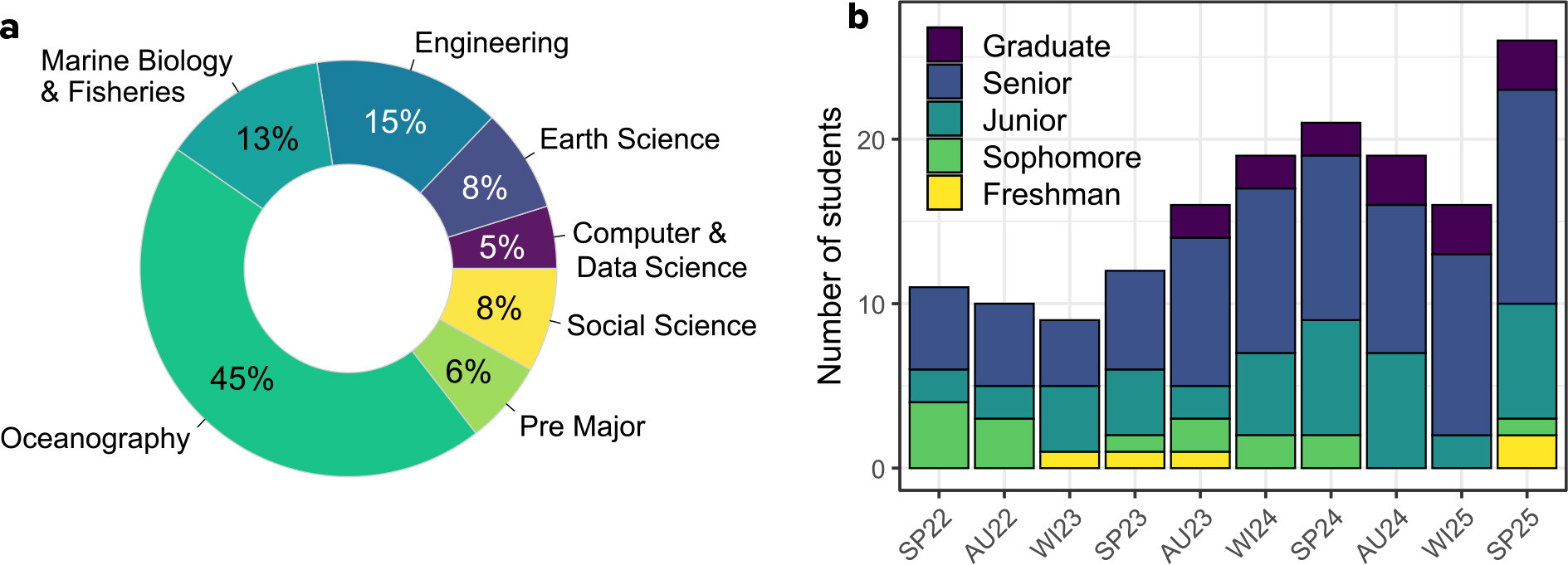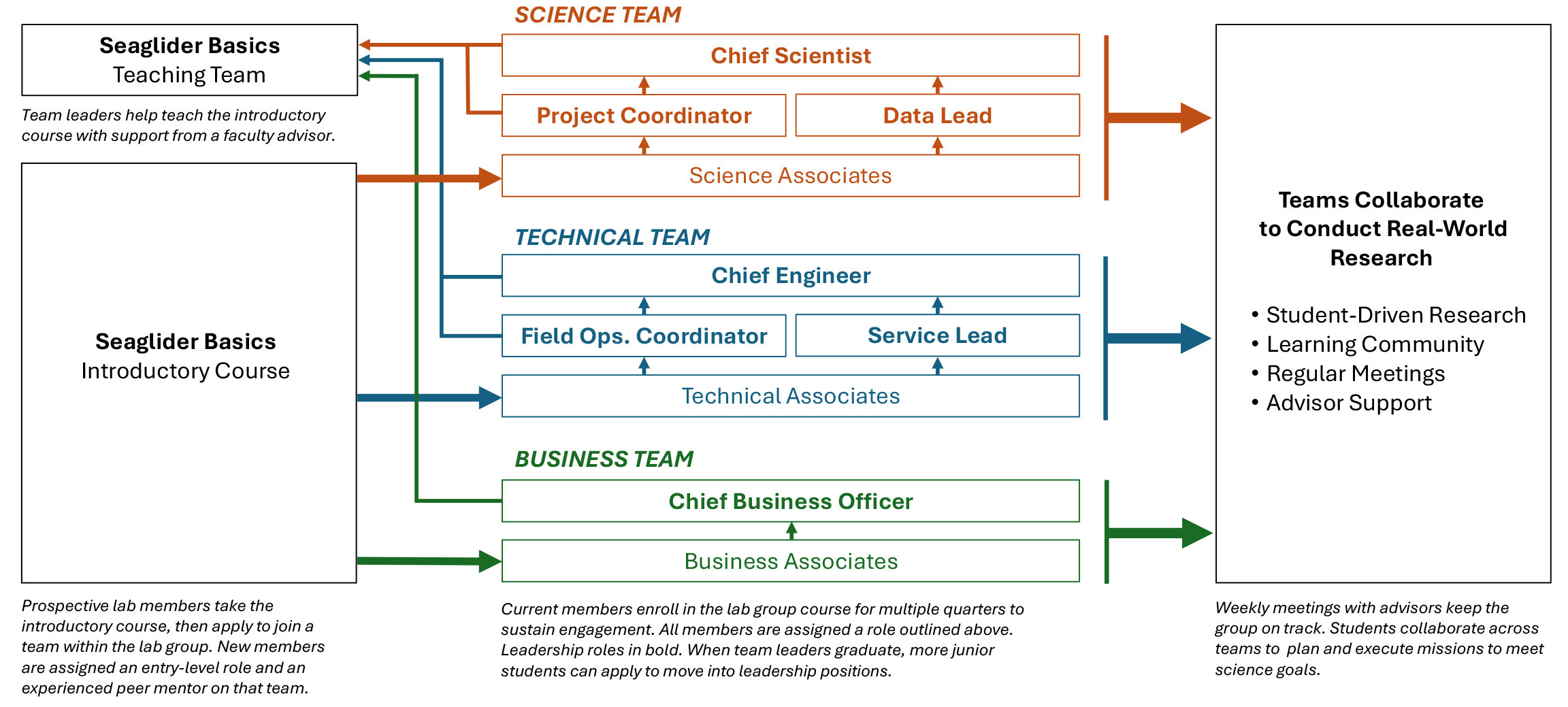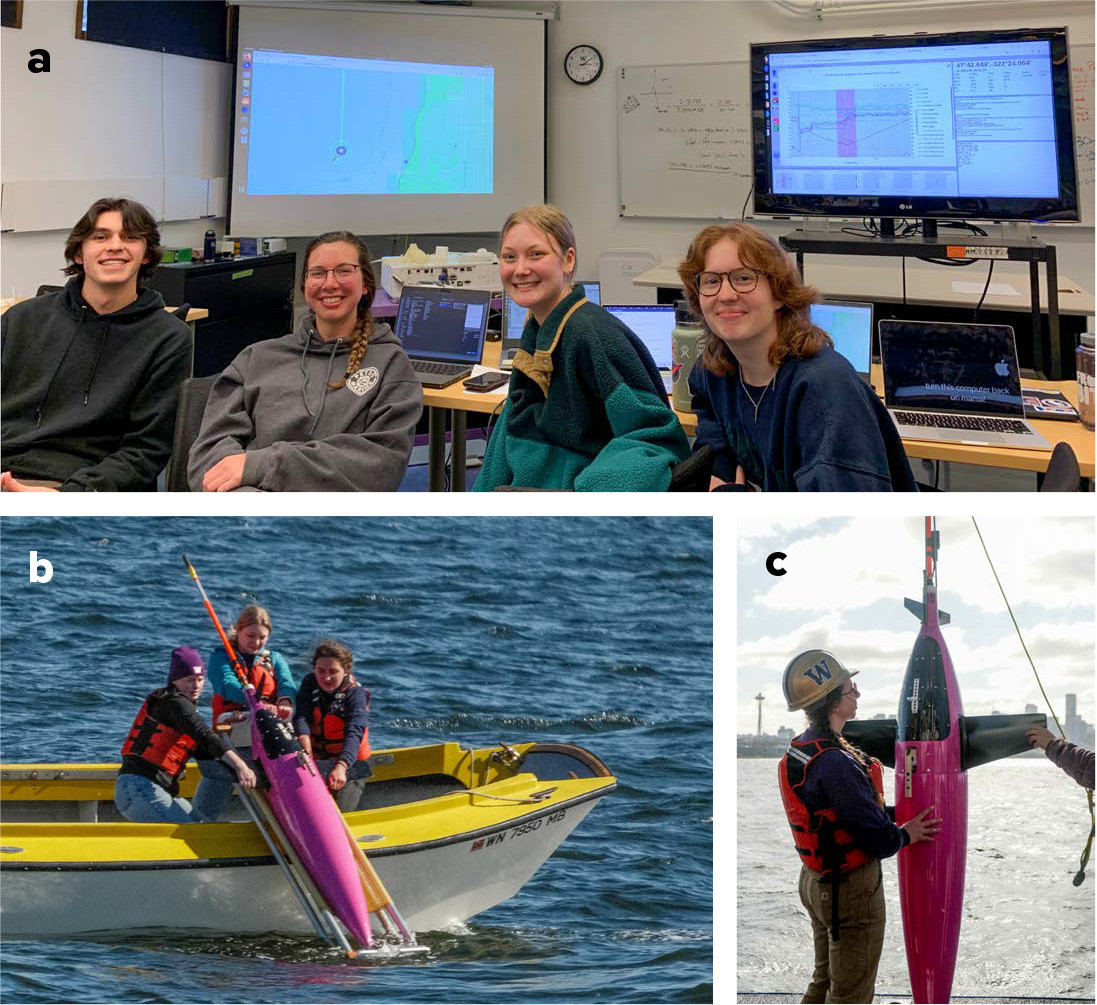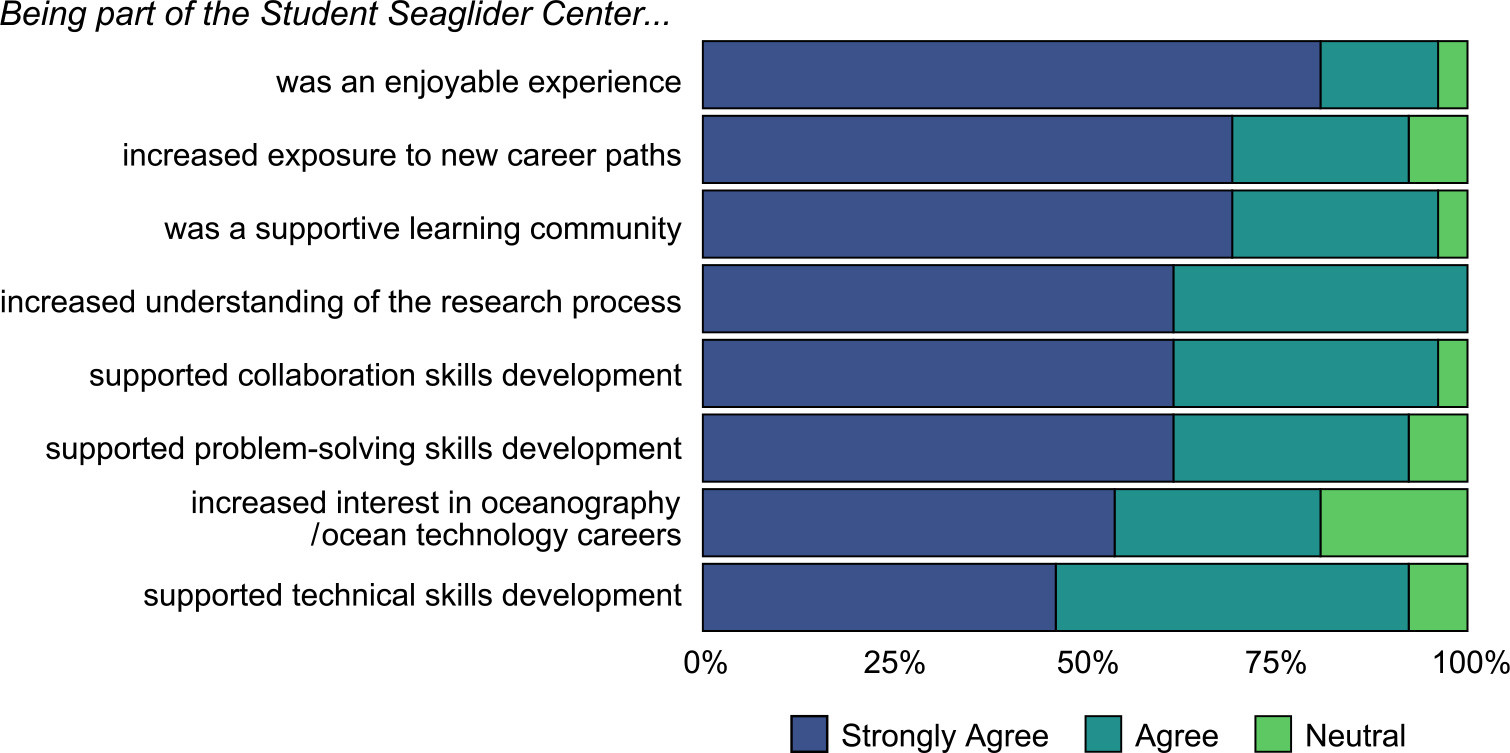Introduction
Recent reports on the transition toward a sustainable ocean economy, also called the new blue economy, highlight a growing opportunity for job creation across a variety of marine industries, with employment growth projections of 51 million jobs globally by 2050 (Ben Hassen et al., 2025). Projections emphasize growth and employment in marine science, engineering, technology, and innovation as employers seek candidates who are trained across these disciplines (Jugan, 2018). There is demand for specialized expertise in advanced marine technologies (e.g., remotely operated vehicles, autonomous underwater vehicles), as well as for capacity in Earth observation, data analysis, and project management (Ben Hassen et al., 2025). The new blue economy workforce will also require transdisciplinary training, particularly the ability to integrate science, engineering, and business leadership, and an understanding of interdisciplinary collaboration (Hotaling, 2021; Moran, 2021).
Student research experiences in marine science could help support the interdisciplinary workforce needs of the new blue economy. Undergraduate research experiences have been shown to enhance students’ likelihood of entering the STEM workforce, with longer research experiences improving student retention and facilitating broader participation (Hernandez et al., 2018; Estrada et al., 2018). Early exposure, particularly within the first two years of college, is especially impactful, with structured learning communities offering additional support for student success and retention (Solanki et al., 2019). Furthermore, commonly sought after skills for entry-level geoscience positions such as collaboration, problem solving, communication, and quantitative data-related skills can be honed through undergraduate research experiences (Shafer et al., 2023). Acknowledging the impact of undergraduate research experiences, course-based undergraduate research experiences (CUREs) have sought to provide these experiences to a broader group of students through coursework (Auchincloss et al., 2014; Brown et al., 2024), a more accessible alternative to the traditional one-on-one faculty mentorship model (Bangera and Brownell, 2014). CUREs often result in authentic contributions to science as they integrate research practices and scientific discovery into courses that provide students with opportunities to conduct real, collaborative research of interest to the scientific community (Auchincloss et al., 2014).
The student-run laboratory, defined here as a laboratory-based group comprised of students who collaborate to complete all aspects of the research process with support from experienced advisors, builds on the CURE concept that offers a scalable and authentic method for providing undergraduate research experience and supporting workforce development needs. The student-run laboratory model expands the CURE model across multiple years of engagement, provides leadership opportunities, includes graduate student mentors, and integrates other evidence-based structural elements that support student success. These include engaging students in a collaborative learning community that supports student retention and achievement (Solanki et al., 2019) and utilizing near-peer mentoring that also supports student retention, enhances scientific identity, and builds confidence and skills for both mentees and mentors (Anderson et al., 2019; Torres et al., 2023). The student-run laboratory structure enables participants to develop both technical and interpersonal skills in a team-oriented setting while fostering a strong sense of belonging and ownership over their learning. By building on the structural elements of CUREs, student-run laboratories create opportunities for a broader cohort of undergraduates to gain meaningful, technical experience while fostering leadership, project ownership, and interdisciplinary collaboration.
The University of Washington’s Student Seaglider Center (SSC) aims to serve as a model for expanding access to undergraduate research and technical education. Its goals are to provide students with hands-on, real-world, and applied scientific and technical experience using Seaglider autonomous underwater vehicles (AUVs) that collect oceanographic data (Eriksen et al., 2001). The SSC supports early and sustained undergraduate involvement in oceanographic research by combining hands-on technical work with structured near-peer mentoring and a collaborative learning environment, building on other successful initiatives that involve undergraduates in AUV operations (Glenn et al., 2011; Gradone et al., 2025). Graduate student mentors provide important support in mission design and training while gaining valuable professional development and scientific experience themselves. With a large and diversely skilled team, students can specialize in different aspects of the laboratory’s operations, including engineering, fundraising, mission planning, and data analysis, enabling students with varying skill sets to participate. Here, we describe the design, implementation, and outcomes of the SSC as an example of how student-run laboratories can serve as scalable and inclusive pathways for building the next generation of the blue economy workforce.
Design and Structure of the Student Seaglider Center
The Student Seaglider Center was founded in spring 2022 with five donated, previously used Seagliders. Being situated at a highly ranked school of oceanography provides the SSC with access to expertise, resources, and a local network of professionals for support. Four experienced advisors provide administrative and structural support and help students as they make scientific decisions and conduct technical procedures. The laboratory occupies the space of the original Seaglider laboratory run by Charles Eriksen and enjoys many resources that have been repurposed for student use, including some parts of the former University of Washington Seaglider Fabrication Center that built the vehicles donated to the SSC. Since its founding, 49 students have participated in laboratory endeavors; they represent 23 academic majors that include geosciences, social sciences, engineering, and computer and data sciences (Figure 1).

FIGURE 1. (a) Distribution of academic majors of all students who have participated in the University of Washington Student Seaglider Center (SSC) since its establishment (spring 2022 to spring 2025). (b) Total SSC membership including composition of students by year status each academic quarter (AU=Autumn, WI=Winter, SP = Spring). > High res figure
|
Students receive course credit for participating in the laboratory. We created a specific class code for the laboratory that has variable credit and is repeatable to enable students to engage for multiple quarters. The average length of student engagement has been three to four quarters, with some engaging upward of three years. Students can register for one to five credits per quarter depending on the amount of time they devote to laboratory activities each quarter (1 credit = 3 hours per week) and can take a maximum of 15 credits total. The laboratory group meets as a whole for one hour per week. Students spend additional credit hours in the laboratory servicing gliders or in smaller team meetings to work on specific tasks. They submit weekly progress reports as assignments for the course, with additional prompts to reflect on their skill building and development.
Students participating in the laboratory join one of three teams: Science, Technical, and Business (Figure 2). The Science Team develops scientific objectives, plans missions, pilots gliders during missions, analyzes data, and presents results. The Technical Team services and ballasts gliders, prepares them for field deployments, and leads field operations. The Business Team applies for funding and oversees budgeting, purchasing, inventory, and communications. This three-team organization promotes student understanding of the different types of roles and expertise involved in doing oceanographic science using advanced technology. Within each team, students are assigned specific roles with clear position descriptions and expectations. Each team has a designated leader: Chief Scientist, Chief Engineer, and Chief Business Officer. There are also mid-tier leadership positions such as Data Management Lead and Project Coordinator for the Science Team and Service Lead and Field Operations Coordinator for the Technical Team. Students with at least one quarter of experience can apply for a team leadership position when it becomes available. New leads overlap with the previous leads for one quarter to ensure transfer of knowledge. All three teams also have entry-level positions (Science Associate, Technical Associate, and Business Associate) for new members or experienced members who are not interested in leadership positions. All teams have students who represent a range of experience, and we prioritize new members who are early in their undergraduate careers so that they have time to gain expertise and move into leadership positions. This structure encourages collaboration through specialized teams, emulating how real oceanographic science is done, similar to other educational AUV research programs (Gradone et al., 2025). These varied roles also facilitate accessible and inclusive field research similar to prior successful models of collaborative field experiences that utilize technology to involve students of all physical abilities (Atchison et al., 2019; Marshall et al., 2022). For example, without physically being in the field, students can pilot gliders remotely and engage in fieldwork through communication with a field team that is deploying or recovering gliders and making decisions in real time in collaboration with the pilots.

FIGURE 2. Diagram of the structural model used by the SSC outlining how students join, are mentored by peers, and collaborate on research in the student-run laboratory. Important elements include an introductory course to orient prospective members, specialized teams that collaborate within the larger group, clear roles and leadership positions, and peer mentoring and teaching opportunities for more experienced students. > High res figure
|
Students are recruited in the fall through outreach events directed to related introductory-level courses and an ocean technology open house on campus. New students join the SSC by first enrolling in a quarter-long Seaglider Basics course offered once per year in winter quarter (Figure 2). Developed and taught by the SSC student leadership with support from an SSC advisor, the course introduces students to critical topics and processes of the SSC. Student leaders alternate leading lessons each week based on their areas of expertise. This course both enables prospective members’ understanding of laboratory processes and supports student leaders in solidifying their knowledge through teaching. Interested students can then apply to join the SSC in the subsequent quarter. Students are placed on teams based on their indicated preferences, satisfactory performance in the introductory course, and available positions. This allows students to join in cohorts with a baseline knowledge of what all teams do along with a basic understanding of gliders.
A key component of the laboratory design and structure is near-peer mentoring: the Seaglider Basics course is conducted by student leaders, new members are assigned a more experienced mentor, and graduate students play an important role in mentoring undergraduates. Currently, graduate students serve two of the three leadership positions on the Science Team (Chief Scientist, Project Coordinator). This enables them to gain experience as principal investigators, developing skills in management, planning, and coordination while lending their expertise to science missions, data analysis, and mentoring undergraduate research projects. Graduate students can engage for longer periods of time, meaning they play a key role in sustaining continuity, retaining institutional knowledge, and facilitating smooth turnover from year to year. This mentoring structure also builds on elements from a similar successful glider education initiative at Rutgers University that uses an apprenticeship model of “watch one, do one, teach one” to enable students to develop skills through teaching peers (Glenn et al., 2011).
All scientific projects are generated, developed, and led by the students. To date, students have conducted one eight-month open-ocean mission in the tropical Pacific and over a dozen shorter local missions and test dives in Puget Sound, Washington. The open-ocean mission investigated the subsurface structure of tropical instability waves using a Seaglider deployed in coordination with NOAA’s Tropical Pacific Observing System (TPOS) Saildrones (uncrewed surface vehicles) and supported a graduate student mentor’s research interests. The goals were to (1) improve operational coordination between autonomous underwater and surface platforms, and (2) obtain a holistic view of both the air-sea interface and the subsurface ocean. One local project investigated water circulation in Puget Sound’s Colvos Passage by simultaneously deploying three gliders to track different water masses, and another established a Puget Sound time series of two-week glider missions in fall and spring to investigate changes over time (Figure 3). In addition to supporting research goals, the time-series project facilitates student training with regular repeated missions. SSC students have presented the findings of their research at local, national, and international conferences.

FIGURE 3. Students are shown participating in SSC activities, including (a) piloting a glider remotely from campus and (b,c) conducting deployments and recoveries locally in Puget Sound. > High res figure
|
Demonstrated Outcomes for Students
Survey Population
To assess the impact of the SSC experience on student development, we conducted two surveys: one for current students and one for laboratory alumni. All 26 current SSC students completed the survey, including 38% who held leadership positions. Participants represented a range of team roles, with 16% belonging to the Business Team, 38% to the Science Team, and 46% to the Technical Team. Sixty-five percent of students had been part of the SSC for one academic year (three quarters) or less, 19% had participated for between one and two years, and 16% had been involved for more than two years. Eleven out of 16 eligible SSC alumni (those at least one year beyond graduation) completed the alumni survey.
Survey Content
We asked current students to report their team, leadership status, and number of quarters they had been in the SSC. We also asked them about the degree to which they agreed with various statements about their SSC experiences on a five-point Likert scale from strongly agree to strongly disagree (Figure 4). Statements included exposure to and interest in career paths, skill building, and development, and assessed different structural components of the SSC including how peer mentoring and access to professional advisors supported learning. We also asked one open-ended question about the most important thing students gained from their SSC experiences thus far and used those responses to identify common themes for analysis: (1) technical skill development, (2) career direction, (3) leadership and confidence, (4) collaboration, communication, and teamwork, (5) understanding how research works and research operations, and (6) peer mentorship. We calculated the proportion of responses that mentioned each theme. Responses that mentioned multiple themes were counted once for each theme.

FIGURE 4. Likert-scale survey responses from current SSC students depict the degree to which they agree with the statements at left. All 26 students completed the survey. No students answered negatively, so Disagree and Strongly Disagree are not shown. > High res figure
|
The alumni survey asked participants to classify their current position type (employed, graduate student, other), current field (oceanography/ocean technology, another STEM field, non-STEM field), how important the SSC experience was to securing their current position (five-point Likert scale from not important at all to very important), and an open-ended response to explain their answers. As with the current student survey, we identified common themes that emerged from the responses, including (1) field-specific technical skills, (2) transferable skill development, and (3) direct connection to career advancement or readiness for graduate school. We then calculated the proportion of responses that mentioned those themes.
Survey Results and Discussion
Current student responses indicated strong support for both professional and peer-based learning structures within the SSC. A vast majority of respondents (96%) agreed or strongly agreed that access to professional advisors was essential to supporting their learning. Additionally, 88% agreed or strongly agreed that peer mentoring, including one-on-one guidance from student leaders and instruction from peers through the Seaglider Basics training, positively contributed to their learning experiences.
Survey results from the Likert-scale questions also indicated participation in the SSC positively impacted students’ skill development and career interests (Figure 4). This was supported by thematic analysis of open-ended responses regarding students’ most significant gains. The most frequently cited gain was technical skill development (46% of responses), including experience with instrumentation, coding, and data analysis, followed by career direction (35%), collaboration, communication, and teamwork (31%), and understanding research operations (23%). Other less common responses included leadership and confidence building (15%) and peer mentoring experience (15%). Selected student quotes below emphasize these results:
- The most significant thing I have gained from SSC is a path. Never did I ever think that I would be working on Seagliders and would ever want to make that into my career (didn’t even know it existed).
- The most significant thing that I have gained from SSC is the valuable knowledge I gained about how to maintain, deploy, and build marine AUVs. I also learned a lot of valuable technical skills, and at the same time had the ability to become a leader.
- Watching, learning, and engaging in the process of separate teams on a large project collaborating and communicating—within teams and across teams—to achieve ultimate shared goals of conducting meaningful scientific research has been deeply valuable.
These findings suggest that the SSC not only supports technical and professional growth but also fosters a strong sense of community and purpose among its members.
For the alumni survey, seven of the respondents reported they were still in the field of oceanography or ocean technology; four were employed and three were graduate students. Three of the respondents reported they were in a STEM field outside oceanography, two employed and one in graduate school. One respondent reported employment in a non-STEM field. Ten out of 11 alumni responded that the SSC was slightly or very important to helping them secure their current positions.
Analysis of open-ended responses explaining the SSC’s impact on current positions supported these patterns. Students cited the importance of technical skill development relevant to their current fields (64%), including experience with data analysis, Linux, sensors, and AUVs. Responses also mentioned transferable professional skill development (55%), such as communication, troubleshooting, collaboration, and project management, as particularly valuable in their current roles, even for those working outside the field of oceanography. Sixty-four percent credited the SSC with contributing directly to their career advancement, including job placement, networking, and graduate school readiness. We also noted that all former leaders of the Science and Technical Teams were currently employed in oceanography and ocean technology. Selected alumni quotes are highlighted below:
- My current position hired me specifically because of my experience with the SSC.
- During my time with the SSC, I was able to gain valuable experience working with autonomous underwater sensors and vehicles. This has directly improved my ability to work as a technician. I was also able to collaborate with students planning deployments and working on various data projects. This experience has prepared me well for the work I am currently doing.
- The SSC was helpful not necessarily because my position requires the technical skills I learned in the SSC, but rather skills such as troubleshooting, communication, organization, and general problem-solving techniques that were integral in our lab to complete repairs, deploy gliders, and effectively communicate with other teams within our center. I believe that even if one does not pursue a career in ocean tech, the SSC prepares students to have desirable skillsets for a majority of careers out there, given the collaboration and planning that the center requires its members to partake in to run smoothly.
Such comments indicate that the SSC equips students with both domain-specific and broadly transferable skills that support diverse career pathways. We plan to continue to survey current students and SSC alumni once per year to understand their perspectives on the benefits of the experience and how it contributes to career development over time.
Lessons Learned and Recommendations
We have demonstrated that student-run laboratories, like the Student Seaglider Center, have the potential to positively impact students’ career development and trajectories relevant to the blue economy and beyond. For instructors looking to implement similar student-run laboratories, our model (Figure 2) could be adapted for a variety of themes or technologies that enable students to make environmental observations (e.g., remotely operated vehicles, drones, various sensors). While the SSC was fortunate to receive donated high-cost equipment for student use, lower-budget alternatives could also utilize this model to provide scalable research experience, for example, in a modified citizen science initiative in which students are responsible for planning projects, collecting and managing data, and presenting results.
Through this experience of building the SSC, we identified key challenges associated with facilitating a student-run laboratory. Managing a large group of students and making sure that all members are included and on task requires clear organization, articulated expectations, and structure. This can include clearly defined student roles, sub-groups with different responsibilities, and a detailed laboratory manual that provides technical protocols and guidelines for project management, authorship, and data and code management. With higher member turnover than traditional laboratories, student-run laboratories need to have procedures in place to reduce knowledge loss when students graduate and effective recruitment strategies for onboarding new students. Cohort-based onboarding and training by student leaders provides structured orientation for new members and further builds confidence for leaders. Near-peer mentorship also reduces knowledge loss and supports laboratory community development that helps sustain student involvement. Graduate students also play a critical role by providing advanced technical expertise while gaining professional development in mentorship, management, and research practices that prepare them for leadership in research careers. Finally, professional advisors play an important role in providing technical advice and facilitating connection and networking with the broader scientific community. The level of advisor involvement can likely vary with the complexity of technology used and the research theme of the student-run laboratory. Advisors should not establish themselves as leaders but rather need to strike a balance between supporting students in making research decisions and enabling them to learn from productive mistakes, acting like bumpers along a bowling lane.
Student-run laboratories offer a vehicle for helping students develop technical and professional skills that are vital for career development through conducting valuable scientific research. The experience students gain as members of the SSC demonstrates the value of an accessible and inclusive organizational structure, the cultivation of a strong learning community, and the use of near-peer mentorship that benefits both mentors and mentees. Our work indicates that the student-run laboratory model can be one way of supporting the goals of the new blue economy workforce and an impactful way to engage and train students for future careers in academia, industry, and beyond.
Acknowledgments
We thank all the current and past student members and the advisors of the Student Seaglider Center and the University of Washington School of Oceanography, Applied Physics Laboratory, and the Department of Aeronautics and Astronautics for equipment donations and support, and we greatly appreciate funding from the UW Student Technology Fee, UW School of Oceanography, and Advanced Offshore Operations Inc.




